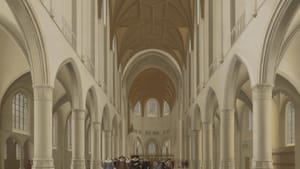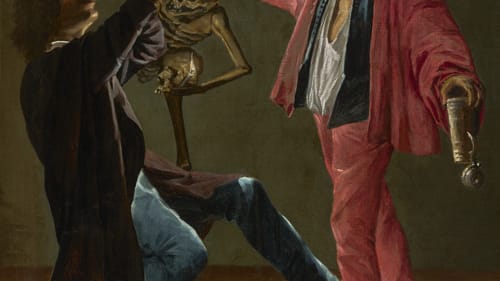Stay in the Loop
BSR publishes on a weekly schedule, with an email newsletter every Wednesday and Thursday morning. There’s no paywall, and subscribing is always free.
A collection with secrets to tell
Philadelphia Museum of Art's 'Old Masters Now: Celebrating the Johnson Collection'

The greatest lawyer of his time in the English-speaking world, John G. Johnson (1841-1917) turned down two Supreme Court posts and the office of U.S. Attorney General to focus on his extensive Philadelphia legal practice. He also amassed a collection of 1,480 objects that includes the art of his contemporaries and old masters, many on view in Old Masters Now: Celebrating the Johnson Collection at the Philadelphia Museum of Art (PMA).
Before expanding to high-ceilinged galleries, the show opens intimately, with fascinating visuals of Johnson’s two stately Philadelphia homes (at 426 and 506 South Broad Street). Full-wall photomurals reproduce two of his art rooms, crammed with paintings in an idiosyncratic way we might call hoarding, but which was the 19th century’s idea of bountiful. The photographs convey the zest and appetite with which Johnson gobbled up the art he loved.
His first collecting forays were done on his own, without advisors; like many collectors, he began by buying works from artists of his time. We see Rosa Bonheur’s striking canine portrait “Barbaro After the Hunt” and an 1873 Mary Cassatt, “On the Balcony,” the artist’s first work to be donated to a museum. Manet’s “The Battle of the USS Kearsarge and the CSS Alabama” is an 1864 maritime rendering of an American Civil War sea conflict off the coast of France (yes). There are also works by Whistler, Constable, Degas, Homer, and others.
Value beyond the dollar
As it unfolds, the exhibition — like Johnson — heads into the past, showcasing a raft of masterworks. They include Rembrandt’s “Head of Christ” (c. 1648-56), Titian’s powerful and enigmatic “Portrait of Archbishop Filippo Archinto” (1558), and Jan van Eyck’s “Saint Francis of Assisi Receiving the Stigmata” (painted between 1430 and 1432), as well as works by Botticelli, Fra Angelico, and Hieronymus Bosch.

The pieces in this exhibition and the expansive PMA gallery design are both majestic and impressive. But Old Masters Now has wider goals. A passel of curators, conservators, and researchers mounted this look at Johnson’s trove in order to also focus on the study and conservation required to maintain and enhance this collection and others like it. It gives a detailed look at the museum’s work behind the scenes: work that is generally conceptual, seldom understood outside the profession, and rarely illustrated. The exhibition also provides insight into what such a collection means to an institution, including how it can generate scholarship and groundbreaking research that expands the field.
Here, artworks in eight alcoves are set apart by wall color. These focus on specific inquiries, projects, and breakthroughs that give insight into how the Johnson Collection is studied and maintained.
Though a collection might seem to be static, the museum shows how it changes over time. For example, Judith Leyster’s 1629 painting “The Last Drop (The Gay Cavalier)” was always considered a portrait of two jolly men at the end of a rowdy night. But art history scholars discovered there was once a skeleton in this painting, and conservation efforts uncovered it (by removing the over-painting), exposing the artist’s very different meaning. In front of the restored work is a photographic series that documents this striking rediscovery.
In Pieter Jansz’s 1631 “Interior of Saint Bavo, Haarlem,” historical research revealed that what was thought to be an architectural rendering with generic figures added for scale was actually a portrait of a state visit, a sort of documentary featuring real people. And extensive study over many years and several continents led to the discovery that Rogier van der Weyden’s two wood panels, “Crucifixion, with Virgin and Saint John the Evangelist Mourning” (1460), had served as shutters that closed over a major Renaissance altarpiece; these two works testified to its existence. A small interactive model charmingly clarifies the discovery.
The exhibition also has a small display of archival materials, including bills of sale for artworks, as well as a related series of lectures and events. In February, the museum will release its first online publication, The John G. Johnson Collection. It’s especially interesting to have a regional opportunity for a back-to-back look at two highly divergent collections, one the work of a single artist (John Sloan at the Delaware Art Museum) and this masterful exhibition (celebrating the centenary of Johnson’s bequest).
What, When, Where
Old Masters Now: Celebrating the Johnson Collection. Through February 19, 2018, at the Philadelphia Museum of Art, 2600 Benjamin Franklin Parkway, Philadelphia. (215) 763-8100 or philamuseum.org.
Sign up for our newsletter
All of the week's new articles, all in one place. Sign up for the free weekly BSR newsletters, and don't miss a conversation.

 Gail Obenreder
Gail Obenreder